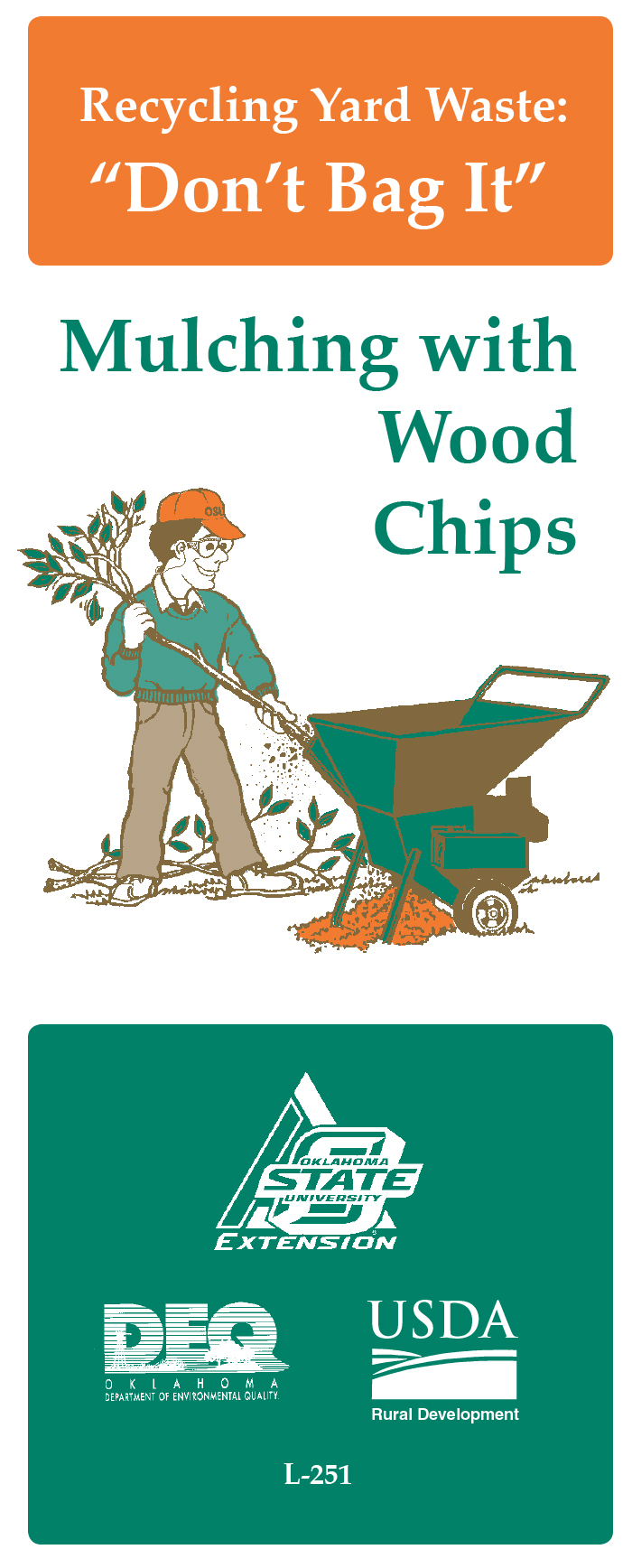Don't Bag It: Mulching with Wood Chips
 In Oklahoma landfills, 20 percent of the waste is from yard debris that consists of
grass clippings, leaves, and woody branches. To lower future garbage costs, we need
to reduce yard waste going to the landfill. Some landfills may ban yard waste. Mulching
tree limbs is a good alternative to landfilling.
In Oklahoma landfills, 20 percent of the waste is from yard debris that consists of
grass clippings, leaves, and woody branches. To lower future garbage costs, we need
to reduce yard waste going to the landfill. Some landfills may ban yard waste. Mulching
tree limbs is a good alternative to landfilling.
Tree limbs and branches can be chipped for use as a mulch or for making pathways. Leaves are best handled through composting. To eliminate grass clippings, check out the “Don’t Bag It” program through your local Oklahoma Cooperative Extension Service office.
Conserving Soil Moisture
Oklahoma is known for its high summer temperatures and strong, gusty winds. In these kinds of weather conditions, a lot of water can be lost from bare soil through evaporation.
A layer of wood chips covering bare soil reduces water evaporation. This means more water for your plants.
With less water loss from the soil surface, you will not have to water as often. You save time, reduce the cost of water, and still have more water for your plants.
Reducing Weeds
A two-inch layer of wood chips shades the soil, reducing weed seed germination. Your plant beds will be cleaner. Weeds that do emerge above the mulch are weak stemmed and easy to pull out by hand.
Cooling the Soil
Bare soil absorbs a high percentage of heat from the sun. Wood chips absorb very little of the sun’s radiant energy, reflecting this heat back into the air.
Tests have shown that a mulched soil can be as much as 30 F cooler than bare soil. Even at a three-inch soil depth, there is still a 15 F temperature difference during a typical Oklahoma summer afternoon.
Wood Chips Have Many Uses
Mulching with wood chips conserves soil moisture, reduces weeds, and cools the soil. All of these benefits help to make your plants healthier. Mulch can help your plants grow faster with fewer insect and disease problems.
Another use for wood chips is to cover garden and yard pathways. Wood chips add a natural element to the landscape.
Finding Wood Chips
Wood chips are a good mulching material for little to no cost. Some communities have free chips from tree trimming projects.
Local tree-care firms with chipping equipment and contractors working for utility companies are good sources for large quantities of wood chips.
Wood chipping equipment that will handle most yard debris chipping can be rented.
Alternative wood chip products are:
- Pine bark mulch, which is readily available, but susceptible to blowing.
- Cypress bark mulch, which is more expensive than pine bark, but does not blow.
Mulching with wood chips:
- Conserves soil moisture
- Reduces weeds
- Cools the soil
What Are the Drawbacks of Using Wood Chips for Mulch?
Wood chips can burn, so caution needs to be exercised with open flames or flammable liquids. Never use charcoal grills or torches over wood chips.
Black walnut trees should not be chipped for landscape wood chip use. Black walnut trunks, branches, and roots contain naturally occurring chemical compounds that inhibit plant growth.
Wood chips have the highest carbon content of any mulch materials. In order for soil organisms to break down wood chips, they must use nitrogen. In some situations, this can tie up nitrogen needed for plant growth. Watch plants for an overall yellowish cast on both older and younger leaves.
If wood chips are used adjacent to buildings, they may serve as a hospitable environment for termites. Keep mulch 6 inches or more away from the foundation. Soil treatment along the foundation area prior to spreading wood chips and yearly retreatments will help discourage termite development in these areas. Consult with a certified pesticide applicator.
To Learn More About Recycling Yard Waste
- Contact your county Oklahoma Cooperative Extension Service office. The phone number
is listed under County Government. Ask for:
L-252 Leaf Composting
L-253 Lawn Care Plan -
Watch “Oklahoma Gardening” on OETA Saturdays at 11:00 a.m. or Sundays at 3:30 p.m.
-
Find more information, including OSU Extension Facts, at: http://www.oces.okstate.edu/
-
This brochure and others may be found on the publications database at: osufacts.okstate.edu
This publication is a joint project of the Oklahoma Department of Environmental Quality, Oklahoma Cooperative Extension Service and USDA.
David Hillock
